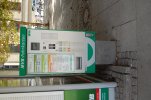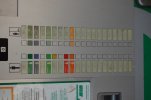Regarding machines of the more recent era: I will start by giving my usual plug for The Transport Ticket Society, which has extremely comprehensive publications on this subject and many others, including full listings of every known self-service machine since the start of BR's experimental operations in the early 1980s! (And in fact all types of ticket machine and device.)
A brief overview of the experimental POTIS machines (Passenger Operated Ticket Issuing System) to start with:
- Agiticket: introduced August 1983 at London Charing Cross and London Bridge (1 each). 40 destination buttons. Replaced by the first Ascom-Autelca machines (more on these later).
- Crouzet: introduced 1987 at Putney (2 machines) as part of a 3-manufacturer trial by BR. Very short lived.
- Westinghouse: as above; 2 machines at London Bridge.
- Thorn EMI (mfrs of the APTIS system used in ticket offices): two machines, initially at Abbey Wood, but then moved to stations on the Shrewsbury-Wolverhampton line between 1988 and 1989.
All of these were succeeded by the early Ascom-Autelca machines (B100, B8011 and B8020), which were essentially identical. I saw a question above about banknotes - this generation did not accept them.
- B8011: the basic model with 32 buttons offering combinations of destinations and ticket type (e.g. "Putney Cheap Day Return"). First examples installed mid-1985 at major suburban London stations. Yellow casing.
- B8020: same as B8011 except with red casing.
- B100: larger, with many more buttons, and separate buttons for destination and ticket type.
All of these issued tickets perforated along the horizontal edge with a notch halfway along both long sides. Returns were issued as 2 attached tickets. Stock did not have a magnetic strip.
Ascom-Autelca B8050 "Quickfare" (the Wikipedia article, which I wrote, has been referred to above): succeeded the above* from late 1989 and lasted until c. 2006 in the Network SouthEast area. Two models: 40 or 92 destination buttons. Separate ticket type buttons. Banknotes accepted from the start.
*Basic timeline (> = replaced by):
- B100s (initially at London termini) > B8050.
- B0811 > B8020 > B8050.
- B8020 > B8050.
B100s were cascaded to stations in Birmingham and Manchester areas (e.g. Birmingham Moor Street, Manchester Airport) where they survived into the 2000s.
B8020s superseded by early B8050s (basically in Greater London) were cascaded to other NSE stations, but were later replaced there by B8050s. (e.g. my local station at the time, Hassocks, got secondhand B8020s in 1990; these were replaced by B8050s in 1993.)
A B8050 is illustrated on the Wikipedia article. The B8011 and B8020s were essentially identical to this machine which I found in use in Magdeburg in 2018 (!), to my delight - see attachments including a close-up of the button configuration.
Hope that's of interest; more to come later, possibly.
Long before "Northern" was a thing. There was one at Huddersfield in around 1992. The red benches found all over West Yorkshire were a WYPTE thing too, though of a similar design to those found in the NSE area.
Obviously there was a limit to how many destinations were possible on those machines, and there were some puzzling anomalies on the Huddersfield one. For example the two Wakefield stations had separate buttons, even though the fares were the same (and may even have been printed as "Wakefield stations" though it's been a while so might be mistaken), but Bradford had one button (this being before the direct service was reintroduced) for both stations. Similarly Manchester had one button for either Piccadilly or Victoria (the Airport was added later IIRC), with another button for "Manchester Central Zone". Another oddity was that there was a button for Bury (via Metrolink) but not one for Altrincham.
I have in my possession a fascinating document about how the "personalities", as they were known, for Quickfare machines were created, including the selection of the destinations. Unfortunately it's only a photocopy and I can't lay my hands on it now. I believe it was published in a railway magazine of some description, but I've never been able to find out which magazine or when.




